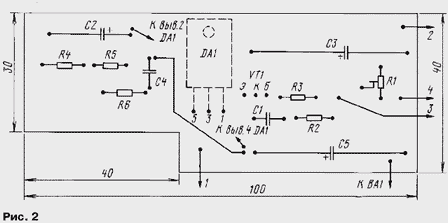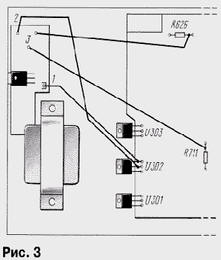
|
|
ENCYCLOPEDIA OF RADIO ELECTRONICS AND ELECTRICAL ENGINEERING Receivers NTV-2000 and NTV-1000 work as radio receivers. Encyclopedia of radio electronics and electrical engineering
Encyclopedia of radio electronics and electrical engineering / Телевидение Reception of satellite TV signals has become commonplace for many - the press quite often discusses the problems of STV, constantly publishes programs of various channels. But with sound broadcasting through the same satellites, probably not everyone is familiar. Meanwhile, it is no less interesting than television. For lovers of creating home music libraries, this is another source of replenishment of their collections. Everyone probably knows that not only television, but also radio broadcasting, including stereophonic broadcasting, is conducted from satellites. It is provided on audio subcarriers that are above the image audio carriers, in the range of 7...8,5 MHz. Such broadcasting is available on many channels of popular satellites of the HOT BIRD series (13 ° E), as well as others, including Gals, where these transmissions are not yet encoded. Naturally, these programs are capable of receiving modern receivers, including NTV-2000 and NTV-1000. However, they only have line outputs and require a power amplifier and speakers to play the received audio programs (without the TV on). There are no problems if the receiver, together with the TV, is located nearby or at least in the same room with the existing sound reproducing complex. Then you only need to connect the audio outputs of the receiver to the inputs of the complex. If this is not possible, then to listen to programs you will have to turn on the TV and use it as a power amplifier and speaker system. The last of these options is hardly considered rational. You can solve the problem in a different way - by installing an ultrasonic frequency converter and a dynamic head in the case of the receiver, there is enough space for this. With such a simple refinement, the receiver turns into a radio receiver. At the same time, the sound reproduction quality cannot be called excellent, but it is in no way inferior to the sound quality of portable, small-sized, and even more so pocket VHF FM radio receivers. The undoubted advantage of the "satellite radio" is its consumer capabilities: using the receiver's remote control, you can switch programs, adjust the volume, turn off the sound ("MUTE" function) and turn off the receiver itself. The proposed version of the revision also provides for the mode of turning on and off the sound reproduction by the internal dynamic head. A diagram of the device that turns the receiver into a radio receiver is shown in fig. 1. The basis of the device is an audio frequency amplifier (UHF) on the K174UN14 chip (it is possible to use its foreign counterpart TDA2003). The amplifier circuit is basically standard, but the VT1 transistor is additionally introduced into it, which ensures that the receiver switches to the "radio receiver" mode.
It happens in the following way. An audio signal is sent to the UZCH input through the volume control resistor R1, the resistor R2 and the capacitor C1 from the linear audio output of the receiver. If the transistor is closed (the control voltage supplied to pin 3 is zero), then the AF signal comes to the input of the microcircuit and it works in the normal mode. When a voltage of 3 ... 5 V is applied to pin 12, the transistor opens, the AF signal closes to a common bus and at the same time the microcircuit's constant voltage mode changes - its output transistors close, i.e. it will exit the amplifying mode. This allows, firstly, to exclude various kinds of acoustic noise and switching interference, and, secondly, in this mode, the current consumed by the microcircuit is reduced (up to 10 ... 15 mA). To switch the operating modes of the receiver, it is convenient to use the "C / ku" command. This is due to the fact that most satellite television programs are located in the Ku-band (10,7 ... 12,75 GHz), and the C-band (3,7 ... 4,2 GHz) is used infrequently. When switching to "C" mode, the polarity of the receiver's output video signal is inverted, so it is impossible to watch it on the TV screen, but in this case this is not required. The control signal can be removed from the output of resistor R711 (closest to jumper J26). On this output in the "ku" mode, the voltage is 12 V, and in the "C" mode it is absent (or significantly less than the transistor opening threshold). The following radio elements can be used in the device: transistor KT3102 with letter indices from A to E, KT312V; polar capacitors - K50-24, non-polar - KM, KLS. Trimmer resistor - SDR, constant - MLT, S2-33. All parts of the device, except for the dynamic head, are placed on a printed circuit board made of one-sided foil fiberglass (Fig. 2).
The board is installed at the side wall of the receiver behind the power transformer (Fig. 3). The microcircuit is soldered to the board with the marking to the board and fastened with a self-tapping screw to the protrusion in the side wall - this ensures the fastening of the board and at the same time heat removal from the microcircuit.
The board is connected to the receiver as follows: pin 1 - to the output of the stabilizer microcircuit U302, pin 2 - to the common power wire (on the U302 chip), pin 3 - to the resistor R711, pin 4 - to the output of the resistor R626 (closest to the SCART connector). The dynamic head must have a resistance of 6 ... 8 ohms and a power of 0,5 ... 1 W. Establishment comes down to setting the maximum volume with resistor R1. The receiver is programmed for receiving radio programs in the same way as for receiving television programs when tuned to one of the programs. But after tuning to the required audio subcarrier, the "C" range is set and the data is entered into the receiver's memory. Author: I. Nechaev, Kursk
Alcohol content of warm beer
07.05.2024 Major risk factor for gambling addiction
07.05.2024 Traffic noise delays the growth of chicks
06.05.2024
▪ The hotel will be served by robots ▪ Budget tracker with Bluetooth for monitoring children ▪ Hypersonic missile is preparing for testing ▪ Toilet bowl with nanomembrane
▪ radio section of the website. Article selection ▪ article Theory and methods of education. Lecture notes ▪ article Over what three seas did the Tver merchant Afanasy Nikitin travel? Detailed answer ▪ article Autogyro-glider. Personal transport ▪ article Electronic soil moisture meter. Encyclopedia of radio electronics and electrical engineering ▪ article High-speed surge protection. Encyclopedia of radio electronics and electrical engineering
Home page | Library | Articles | Website map | Site Reviews www.diagram.com.ua |






 Arabic
Arabic Bengali
Bengali Chinese
Chinese English
English French
French German
German Hebrew
Hebrew Hindi
Hindi Italian
Italian Japanese
Japanese Korean
Korean Malay
Malay Polish
Polish Portuguese
Portuguese Spanish
Spanish Turkish
Turkish Ukrainian
Ukrainian Vietnamese
Vietnamese



 Leave your comment on this article:
Leave your comment on this article: